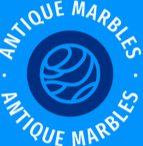Banded Opaque/Banded Translucent/Banded Transparent
Banded Opaque swirls represent an early era of German handmade marbles, often identifiable by a faceted pontil, a sign of manufacturing predating 1880. These marbles are crafted from soft opaque glass and feature bands of color on their surface, frequently showcasing multiple hues.
In instances where no banding is present, and the marble consists solely of opaque glass, it is termed an “Opaque” or sometimes referred to as a “Melonball,” particularly if it exhibits some degree of translucency.
Constructed from lightweight yet fragile glass, Banded Opaques are prone to chipping or cracking easily. Their delicate nature and lack of resilience during play led to diminished popularity among early marble enthusiasts. Consequently, low demand resulted in limited production, rendering these marbles scarce among collectors.
Banded Opaques exhibit varying banding patterns, ranging from haphazard and random to precisely organized bands of color. Generally, marbles with meticulously arranged bands are preferred over those with random constructions.
While most Banded Opaques are crafted from white matrix glass, which can vary from fully opaque to semi-translucent, occasionally, marbles made from other uncommon matrix glass colors are encountered. These may include shades of tan, amber, blue, green, grey, purple, or lavender, enhancing their value.
Black Opaque marbles adorned with surface bands are known as Indian Swirls; although they possess defining characteristics, they are not technically categorized as “Banded Opaques.”
The typical sizes for Banded Opaques range from 9/16 to 3/4 inches. However, any Banded Opaque exceeding 3/4 inches in size, regardless of color, commands a premium. Marbles larger than 7/8 inches are seldom encountered among Banded Opaques.
End of cane or left twist examples of any color type Banded Opaques are rare.
